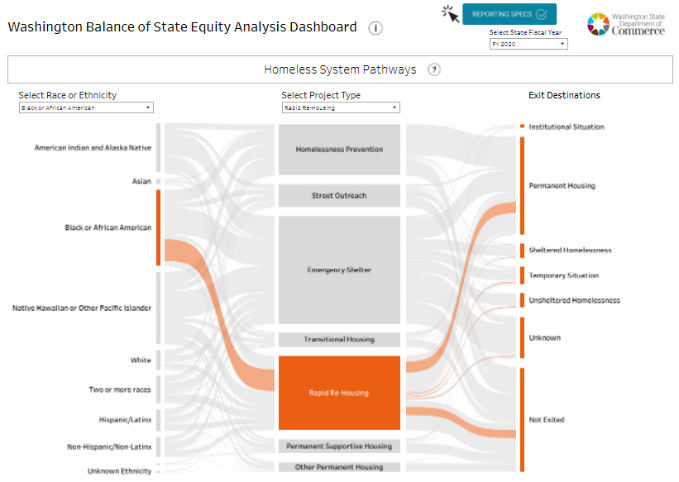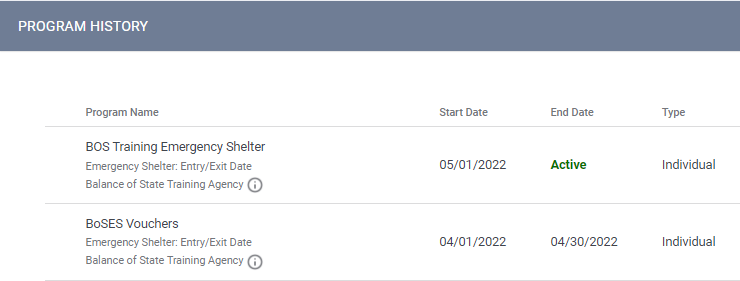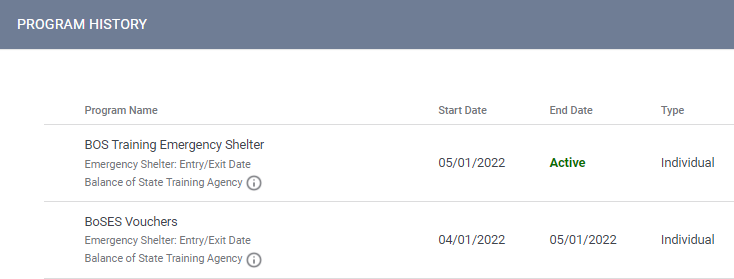Updated equity dashboard
 Check out the Equity Analysis Dashboard. It includes fiscal year 2021 data. This dashboard aims to facilitate the analysis of racial and ethnic disparities among people who are entering homelessness in the Washington Balance of State Continuum of Care (BoS CoC). Because each community has unique circumstances, distilling racial and ethnic disparities to the county or regional level is critical in identifying and changing racial and ethnic bias in each system and service.
 Data dashboards
Dashboards updated for the third quarter of state fiscal year 2022 (Jan. 1 through March 31, 2021):

Findings from the data engagement survey
In April, we asked our HMIS users to provide feedback on how to improve our data quality support efforts, particularly this newsletter and the Data Quality Dashboard. The survey’s purpose is to identify gaps and future topic priorities. Almost 300 agency partners and HMIS users responded. Learn about the initial findings in this Data Engagement Survey article.

 Are you or a colleague trying to figure out how to sign up for this newsletter? Does the newsletter keep popping up in your email junk folder? If so, check these things:
- Mark WAStateCommerce@public.govdelivery.com as a safe sender in your email settings.
- Register for the quarterly newsletter on Commerce’s HMIS webpage by (1) entering your email address and (2) selecting the SUBMIT button. All HMIS users are automatically signed up.
- If you opted out of receiving emails but want to receive them again, then (3) select the “Subscriber Preferences” link to make sure HMIS is included in the list.

We’re excited to announce that Joshua Fike has been promoted to the youth and young adults reports analyst position on the HMIS Data Analytics Team! Joshua started his new position at the beginning of May.
Here is what Joshua has to say:
“I'm excited to start the new role as the Youth and Young Adults Reports Analyst. I have worked as a reporting analyst or with databases for 10 years and have spent the last six months working in HMIS. I am excited to apply what I know in the effort to end youth homelessness. In my spare time, I like to keep engaged in my community and have served as a facilitator for an LGBTQ youth support group, supported candidates running for office and organizations doing policy advocacy. I'm currently a mentor in the Big Brother/Big Sister program.
Congratulations, Joshua!
 Reports corner
Every quarter, we examine a report or reporting-related topic to help you take ownership of your data.
 Excel at Excel basics
Want to be a spreadsheet wizard? Here we explore the power of spreadsheets, from the basics to advanced.
Beginner Tip: Learn about doing additional calculations after pulling a Program Roster Report in this tutorial. We’ll cover some helpful data quality tips from filters to the length of stay.

Consider taking HUD’s Data Analytics On-Demand Course later this year. This on-demand course equips participants with an analytic framework, skills and best practices regarding a Homeless Management Information System (HMIS) ad hoc analysis. It is open to anyone interested in analyzing, interpreting and communicating HMIS data. For questions about this course or when it will be available, contact hmisonlinecourse@cloudburstgroup.com.

Commerce’s Performance Team is hiring! We are looking for someone who is data driven and strategic thinker who is passionate about strengthening services to people experiencing a housing crisis. In this role you will oversee the procurement and provision of annual homeless system grantee training. You will lead and coordinate competitive solicitation processes and manage contracts with third party trainers and consultants in order to provide the training and technical assistance necessary to improve homeless system performance. Additionally, you will supervise one full time staff person.
Apply here: COM 3: Performance Grant Manager
This job posting closes on May 26, 2022, so please share with your networks or apply today. Attention! It is important that applicants carefully examine the required qualifications and ensure that their responses to the supplemental questions reflect that they meet the required qualifications.

Running into technical issues and not sure who to call? Don’t worry — the HMIS team has your back.
One of our readers writes:
Dear HMIS team,
For residential projects, I am not sure how to track the end dates for my program correctly when a client is switching programs. Can you tell me which way is the most accurate?
Truly Yours,
Erroneous End Dates in Ephrata
Dear Erroneous End Dates,
Great question. Page 91 of the HMIS Data Standards Manual (PDF) states that for residential projects, the Project Exit Date represents, “The last day of a continuous stay in the project before the client transfers to another residential project or otherwise stops residing in the project.” In HMIS, residential projects include Emergency Shelter, Transitional Housing and non-Rapid Re-Housing Permanent Housing projects (Permanent Supportive Housing and Other Permanent Housing). Rapid Re-Housing Permanent Housing has specific exit date criteria.
For example, if a person checked into an overnight shelter on 1/30/2022, stayed overnight and left in the morning, the exit date for that shelter stay would be 1/31/2022.
In the scenario below, the client spent April in a hotel/motel voucher program. Then, starting on 5/1/2022, the client moved into an emergency shelter.
The agency entered it this way, but it is incorrect:
 The way that this appears is that they left the shelter program the morning of .
However, what really happened is that on the morning of May 1, they woke up at their temporary residence in the shelter program, so the end date should be 05/01/2022.
This is how it would look if entered correctly:
 Entered this way, there are no time breaks between programs.
If you have additional Help Desk questions, email us at HMIS@commerce.wa.gov.
Best wishes,
HMIS team

|